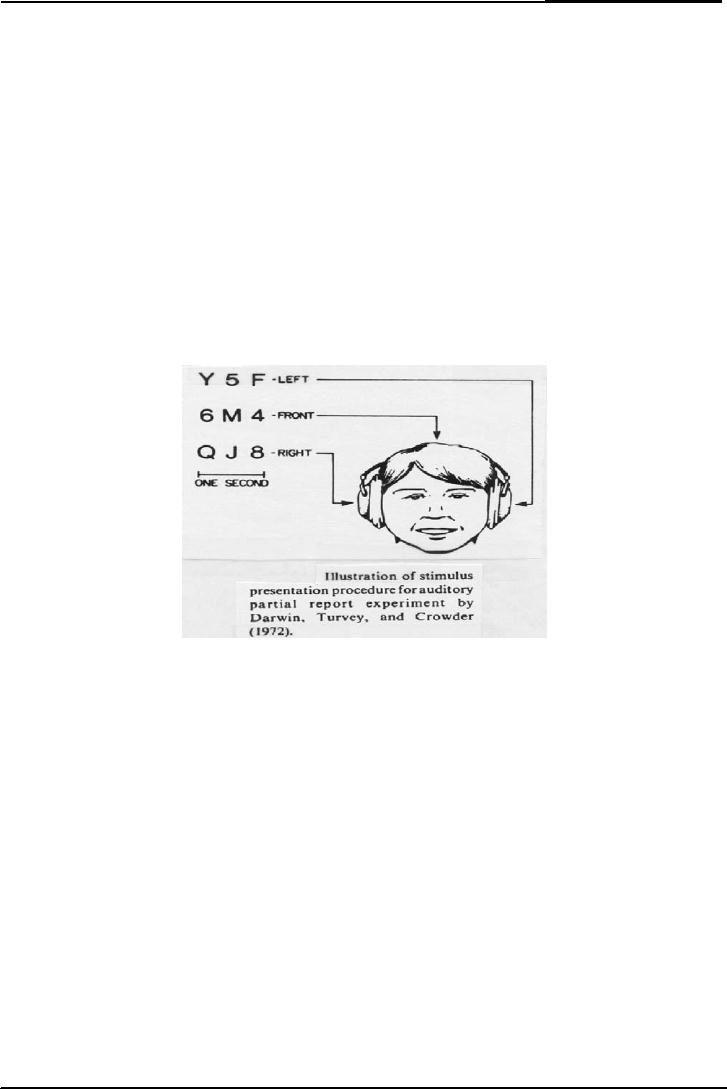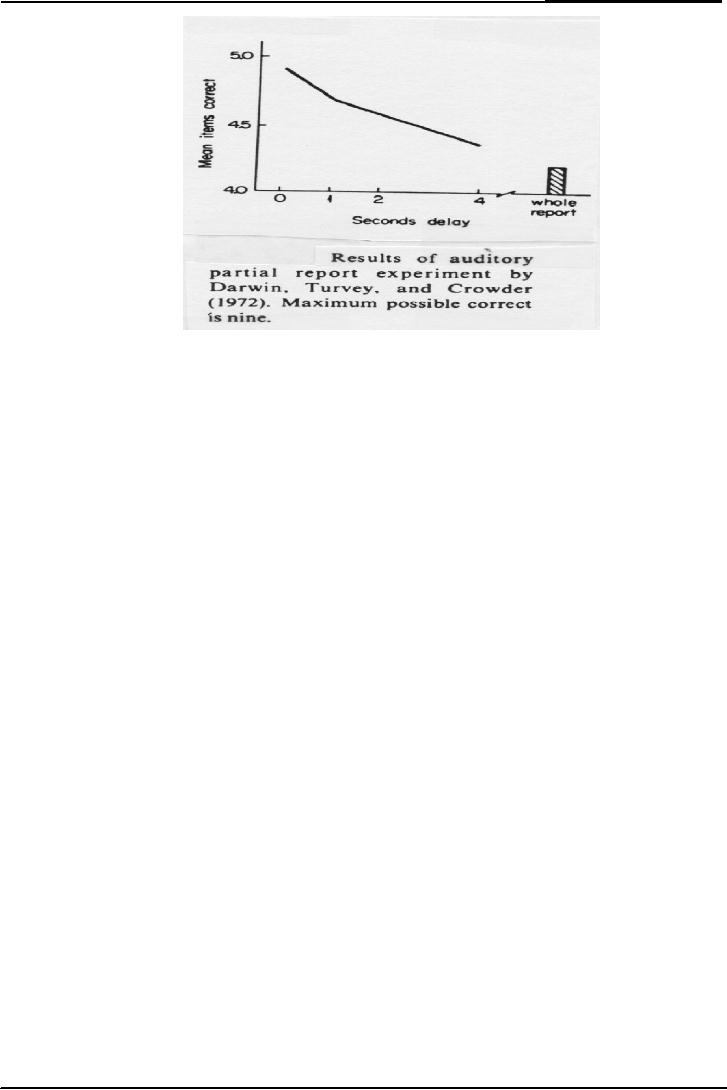 |

Cognitive
Psychology PSY 504
VU
Lesson
06
VISUAL
SENSORY MEMORY EXPERIMENTS
(CONTINUED)
Sperling
(1967) & Neisser
(1967)
Sperling
made another variation and
after that array
disappeared, he made visual
field dark
instead
of white. This produced
fascinating results and the
retention power of the
subjects was
increased
to 5 seconds. He found that
when the postexposure field
was light the
sensory
information
remained for only a second,
but when the field
was dark it remained for a
full 5
seconds.
Light
post-exposure field 1
second
Dark
post-exposure field 5
seconds
Ulric
Neisser wrote first
cognitive psychology book in
1957. He devised a word
icon.
It is a
brief
visual
memory revealed in these
experiments. He devised the
word iconic memory for
short term
visual
memory.
According
to Neisser, the visual
memory is neither short term
memory nor long term
memory but
it
is very very short term
memory and should b called
as iconic memory. Without
such a visual
icon,
perception would be much
more difficult. Many stimuli
are of very duration. In
order to
recognize
them, the system needs
some means of holding on to
them for a short while
until they
can
be analyzed.
Neisser
also reported that if
another display is given
during that one second
when you are
already
retaining an image it is like
erasing or washing out the
first and overwriting the
second
one.
Almost all the information
is held for a very brief
period (1 second). It is quickly
washed out
after
removal of stimulus unless
attention is paid to
it.
The
sensory store is particularly
visual in character and is
sensitive to light. We cannot
pinpoint
where
sensory memory is located in
brain (this is a software
level description not
hardware level
description).
Sensory visual store is not
physical but seems like
physical phenomenon and
is
sensitive
to light.
Psychological
Time
Are
we living in every moment in
this moment or are we living
in the past? The conclusion
is
drawn
about that how we are
judging that we are living
in present not in past. Our
new
information
synthesis with our old
information, as it is happening at the
same time at the
same
space.
If we see the things that
happen before one second we
perceive it as it is happening
here
and
now. We are attending to the
visual information after
some delay no matter how
brief that
period
may be less than one
second. And if we perceive the
information after we have
seen
something.
We know that we are not
living in past we are seeing
things here and now.
This is
called
psychological time. We found
that our perception is
delayed by a second. Our
visual
system
is recombining things within a
second and putting them
together and constructing a
visual
image
based on the information we
receive.
Auditory
Sensory Memory
Evidence
for an auditory sensory
memory similar to the visual
memory comes from the
set of
experiments
by
Moray,
Bates and Barnett (1965),
and
16

Cognitive
Psychology PSY 504
VU
Darwin,
Turvey & Crowder
(1972)
Moray,
Bates and Barnett
(1965)
Their
experiment is copy of Sperling's
experiments. But in this
experiment instead of top,
middle
and
bottom, sounds were
manipulated as coming from
left, right or from the
front side. The
cue
was
presented visual (opposite to
the sperling's experiment,
where the cue was
auditory). In their
experiment,
subjects listened to a recording
over stereo headphones,
hearing three lists of
three
items
read simultaneously. Because of
stereophonic mixing, one
list seemed to come from
the
left
side of the subjects head,
one from the middle,
and the one from
the right side.
The
investigators
compared results from
derived from a whole-report
procedure, in which
subjects
were
instructed to report all
nine items, with
partial-report procedure, in which
they were cued
visually
after the presentation of
the lists as to whether they
should report the items
coming from
the
left, middle, or right
locations. A greater percentage of
the letters were reported in
the partial-
report
procedure than in the
whole-report procedure. It was
statistical significance.
Statistical
significance
means obvious, marked
difference.
Thus
all the information is
available to the short term
sensory storage, but it
quickly decays. The
delay
is significant but not
striking as compared to visual
sensation because visual
sensation is
central
and hearing only supports
it. Neisser (1967) has
called it echoic
memory.
Neisser
pointed out many things we
understand, perceive but
cannot perform them, like
the
difference
between competence and
performance. This was a big
blow to behaviorism.
Cognitive
psychology
scientifically proved that
psychology is much more than
observable behavior
only.
Neisser
conclusion was whole-report
paradigm was a limit to our
production not to our
process.
We
process every thing but we
cannot produce all. Time
delay, overwriting, light
contrast
intervene
in the production aspect not
in the storage
aspect.
17

Cognitive
Psychology PSY 504
VU
Psychological
time
We
all are living in the
past. This past is not in
passive term. Because we
receive visual
information
that is one second old. And
we receive auditory information
that is 5 seconds
old.
Information
is not only being received
but also is being
reconstructed. We are creating
the reality
afresh,
every moment. Every icon is
separate entity. New
information is different entity.
It
reconstructs
reality with combining other
entity. The heart of
cognitive psychology lies in
its
experimentation.
18
Table of Contents:
- INTRODUCTION:Historical Background
- THE INFORMATION PROCESSING APPROACH
- COGNITIVE NEUROPSYCHOLOGY:Brains of Dead People, The Neuron
- COGNITIVE NEUROPSYCHOLOGY (CONTINUED):The Eye, The visual pathway
- COGNITIVE PSYCHOLOGY (CONTINUED):Hubel & Wiesel, Sensory Memory
- VISUAL SENSORY MEMORY EXPERIMENTS (CONTINUED):Psychological Time
- ATTENTION:Single-mindedness, In Shadowing Paradigm, Attention and meaning
- ATTENTION (continued):Implications, Treisman’s Model, Norman’s Model
- ATTENTION (continued):Capacity Models, Arousal, Multimode Theory
- ATTENTION:Subsidiary Task, Capacity Theory, Reaction Time & Accuracy, Implications
- RECAP OF LAST LESSONS:AUTOMATICITY, Automatic Processing
- AUTOMATICITY (continued):Experiment, Implications, Task interference
- AUTOMATICITY (continued):Predicting flight performance, Thought suppression
- PATTERN RECOGNITION:Template Matching Models, Human flexibility
- PATTERN RECOGNITION:Implications, Phonemes, Voicing, Place of articulation
- PATTERN RECOGNITION (continued):Adaptation paradigm
- PATTERN RECOGNITION (continued):Gestalt Theory of Perception
- PATTERN RECOGNITION (continued):Queen Elizabeth’s vase, Palmer (1977)
- OBJECT PERCEPTION (continued):Segmentation, Recognition of object
- ATTENTION & PATTERN RECOGNITION:Word Superiority Effect
- PATTERN RECOGNITION (CONTINUED):Neural Networks, Patterns of connections
- PATTERN RECOGNITION (CONTINUED):Effects of Sentence Context
- MEMORY:Short Term Working Memory, Atkinson & Shiffrin Model
- MEMORY:Rate of forgetting, Size of memory set
- Memory:Activation in a network, Magic number 7, Chunking
- Memory:Chunking, Individual differences in chunking
- MEMORY:THE NATURE OF FORGETTING, Release from PI, Central Executive
- Memory:Atkinson & Shiffrin Model, Long Term Memory, Different kinds of LTM
- Memory:Spread of Activation, Associative Priming, Implications, More Priming
- Memory:Interference, The Critical Assumption, Limited capacity
- Memory:Interference, Historical Memories, Recall versus Recognition
- Memory:Are forgotten memories lost forever?
- Memory:Recognition of lost memories, Representation of knowledge
- Memory:Benefits of Categorization, Levels of Categories
- Memory:Prototype, Rosch and Colleagues, Experiments of Stephen Read
- Memory:Schema Theory, A European Solution, Generalization hierarchies
- Memory:Superset Schemas, Part hierarchy, Slots Have More Schemas
- MEMORY:Representation of knowledge (continued), Memory for stories
- Memory:Representation of knowledge, PQ4R Method, Elaboration
- Memory:Study Methods, Analyze Story Structure, Use Multiple Modalities
- Memory:Mental Imagery, More evidence, Kosslyn yet again, Image Comparison
- Mental Imagery:Eidetic Imagery, Eidetic Psychotherapy, Hot and cold imagery
- Language and thought:Productivity & Regularity, Linguistic Intuition
- Cognitive development:Assimilation, Accommodation, Stage Theory
- Cognitive Development:Gender Identity, Learning Mathematics, Sensory Memory